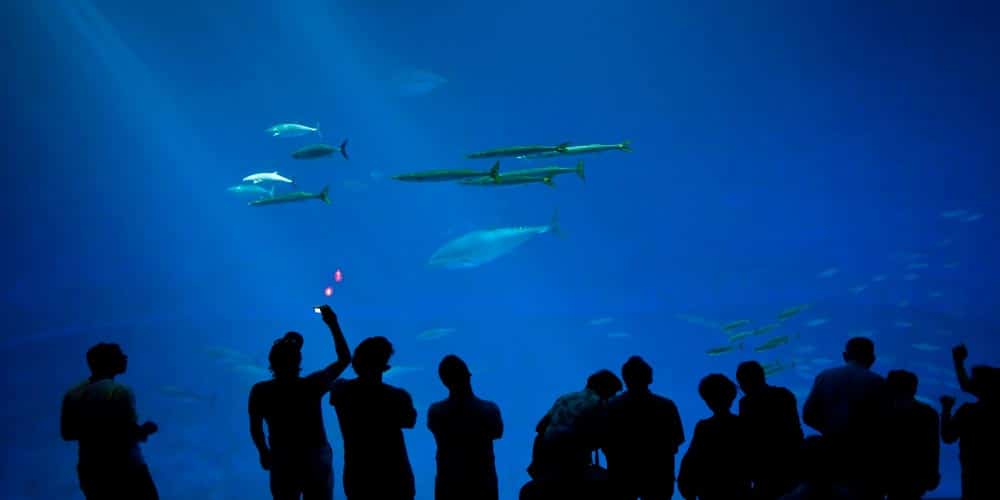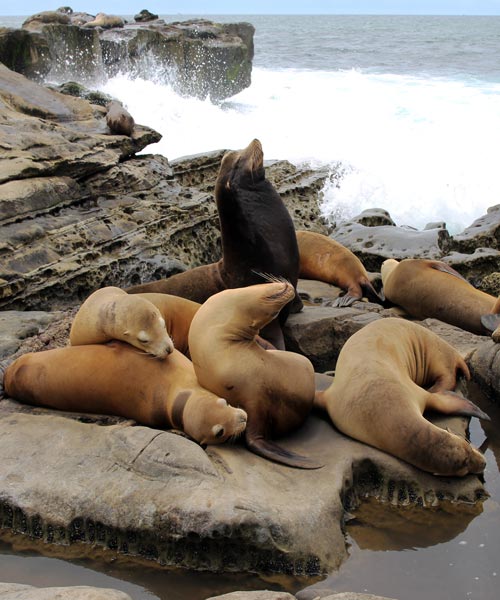Sarah Siese and her daughter, Rosie, set out on California’s Highway 1 to explore the Pacific wildlife

The scenic Highway 1
On the surface, California seems like the Promised Land for families: a charmed and bountiful state with abundant sealife. Or so we thought. Our guides along the coast soon put us right: below the surface, the habitat has been stripped in pursuit of ever-increasing yields and catches. What seemed would last forever disappeared at the turn of the 1900s. Warning signs went unheeded, and many species almost died out. Fortunately, a new era of eco warriors, who accept no compromise in their quest for sustainability (a wisdom cherished by native Americans), have started to renew the land. Today’s pristine coastline is their legacy – a fragile balance that’s in the hands of each new generation.
Molluscs, such as abalone and squid, sea turtles and shark species also share the bay, sheltered by flourishing varieties of giant kelp; it grows a staggering metre a day and becomes as tall as trees, forming a kelp forest. The touch tanks at Seymour Marine Discovery Centre are a living classroom for families where, among others, sea urchins and hermit crabs bring the bay alive, along with nocturnal swell sharks, that enlarge when stressed.
We were encouraged to touch a shark’s egg case made of cartilage, or ‘mermaid’s purse’, then the shark itself, whose hydro-dynamic dermal denticles belied its silky appearance. For kids and adults alike, experiencing is believing.

Highway 1
Some 70 miles south of San Francisco, along the scenic Highway 1, Santa Cruz lured us with its pictures of whale-
watching and surfing – its ‘name to fame’ is the surf idol O’Neill. Well-known as the gateway to Monterey Bay National Marine Sanctuary, covering nearly a quarter of the Californian coastline. For sealife, and particularly whales, the main attraction is an underwater trench that stretches out 60 miles plunging 10,000ft – more than twice the depth of the Grand Canyon.
It’s home to some familiar marine mammals, including cuddly sea otters and seals, and some less familiar ones, like bottlenose dolphins, swell sharks and mighty grey whales. Orcas are sometimes spotted, especially when greys are around, which they hunt during their migration north. It’s called Whale Alley due to the sheer volume that travel 12,000 miles from the Arctic to Mexico’s warm waters, and a day at sea doesn’t pass without spotting at least one whale.

Sarah and her daughter, Rosie, at the beautiful California Coast

Monterey Bay Aquarium
Monterey Bay Aquarium
Aquariums normally feel like a one-way mirror, visitors can see through the glass but the fish seem completely unacquainted: interaction is not an option. The alpha male sheephead fish in the kelp forest doesn’t play by these rules, and has a tendency to stare down outsiders getting too close to the tank.
The aquarium stands by its mission to inspire marine conservation by giving insight and interactivity between families and ocean life. Land and sea. The building itself straddles the two, and is a hub of education, providing information such as the Seafood Watch Guides.
Children learn that a bluefin tuna should live 40 years, while a mahi-mahi lives only a year, making it distinctly more sustainable and desirable on our plate.
There are dozens of beautifully balanced spectacles, from a ceiling roundabout of thousands of racing sardines to three playful surrogate mother otters… all sure to have an impact on the way we view the other 70% of our planet.
Success story
The California grey whale was recently removed from the endangered species list and their estimated population of 26,000 is thought to equal the pre-whaling population.

Seals lounge on the shoreline
Rewilding along Elkhorn Slough
‘Devotion to the ocean’ was Francisco’s catchy mantra, as he directed our kayaking trip along Elkhorn Slough. It’s a place brimming with life created by a rich diversity of wetland creatures. Surprising, then, that less than a century ago it was utterly barren – stripped bare by hunters who yielded thousands of otter pelts a year until only 40 remained. Another of the region’s success stories; there are over 3,000 today.
As the swell of the incoming tide carried us away from the charging Highway 1, we tuned into the surrounding environment. The banks teemed with seals and sea lions lazing in the sun, the chatter of cormorants and grey pelicans, and the regular splashes from well-fed sea otters cracking crabs on their tummies.
Rounding each bend brought a new raft of semiaquatic mammals – a great lazing plump of nocturnal seals, or wreck of seabirds. Its renewed baseline continues to expand after a wonderful transformation.

Rosie goes cave-kayaking
Camping on The Channel Islands
California’s Channel Islands float on the horizon like ribbons of black rock. They’re home to over 6,000 Brown pelicans, but in 1970 they were down to their last pair of chicks due to DDT pesticide flowing from mainland sewers, which contaminated fish stock and disrupted the pelicans’ reproduction systems, thinning their shells, which then crushed during incubation.
Today it is protected by the Nature Conservancy and National Park Service who look after its 77 miles of craggy coastline and expansive beaches. There are marshes, pine forests, morass lands, and chaparral. We didn’t see the mammoth scrub-jay, but the tiny island foxes, reintroduced in 2008, are hard to miss.
The experience begins as soon as you step onto the boat to cross the 19-mile channel to Santa Cruz Island. Halfway across, the boat slowed for a pod of excitable bottlenose dolphins diving in and out of the wake. Moments later, a geyser erupted in front of the bow and a pod of three humpback whales emerged.
Having set up camp, a hike around the five-mile Scorpion Canyon loop revealed views of rolling landscape, steep cliffs and neighbouring Anacapa Island, resembling a
Jurassic world as the clouds folded around its peak.
Returning to camp for an early supper, it was clear we weren’t the only hungry residents. Channel Island foxes masquerade their cunning with cuteness, though we were under strict instruction not to feed them.
With the world’s highest concentration of sea caves here, kayaking is a must. We weaved in and out of the island’s foundations as curious seal pups popped up, splashed their fins, and quickly returned to vigilant mums. Birds are also best seen from this vantage point and strings of pelicans cruise with Exocet precision inches above the glassy surface. We brushed aside cormorants drying their wings, felt the slip of the guillemots’ nosedives, and said hi to a lonesome blue-footed booby.
As the pelicans gave their final fly-by, we saluted them and vowed to return along with the sea otters of yesteryear. Exposure to this wonderland is a privilege and its fragile future is only as secure as the current generation permits. Rosie commented that this kind of experience gives knowledge; knowledge gives power; and power gives the opportunity to create positive change – something she’s wanted since rescuing her first bumblebee aged three.
How to book
Real Holidays offers a 12-night family fly-drive from £1,765pp on a room-only basis based on a family of 4 sharing including economy international flights, and car hire.
Accommodation includes Beach Street Inn, Santa Cruz, just steps from the surf and sand and walking distance of the wharf and boardwalk.
And Captain’s Inn in Moss Landing is the perfect gateway to the Elkhorn Slough wetlands, a comfy B&B within a stone’s throw of ocean’s roar.
Channel Islands
Camping is available year-round on all five islands in Channel Islands National Park. Advanced reservations are required.
Activities
Kayaking in Moss Landing, £27 for single kayak.
Santa Barbara Adventure Company, £115 per adult.
Seymour Centre, £6 per adult.
Monterey Bay Aquarium, £38 per adult.